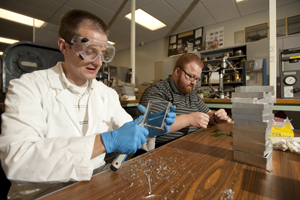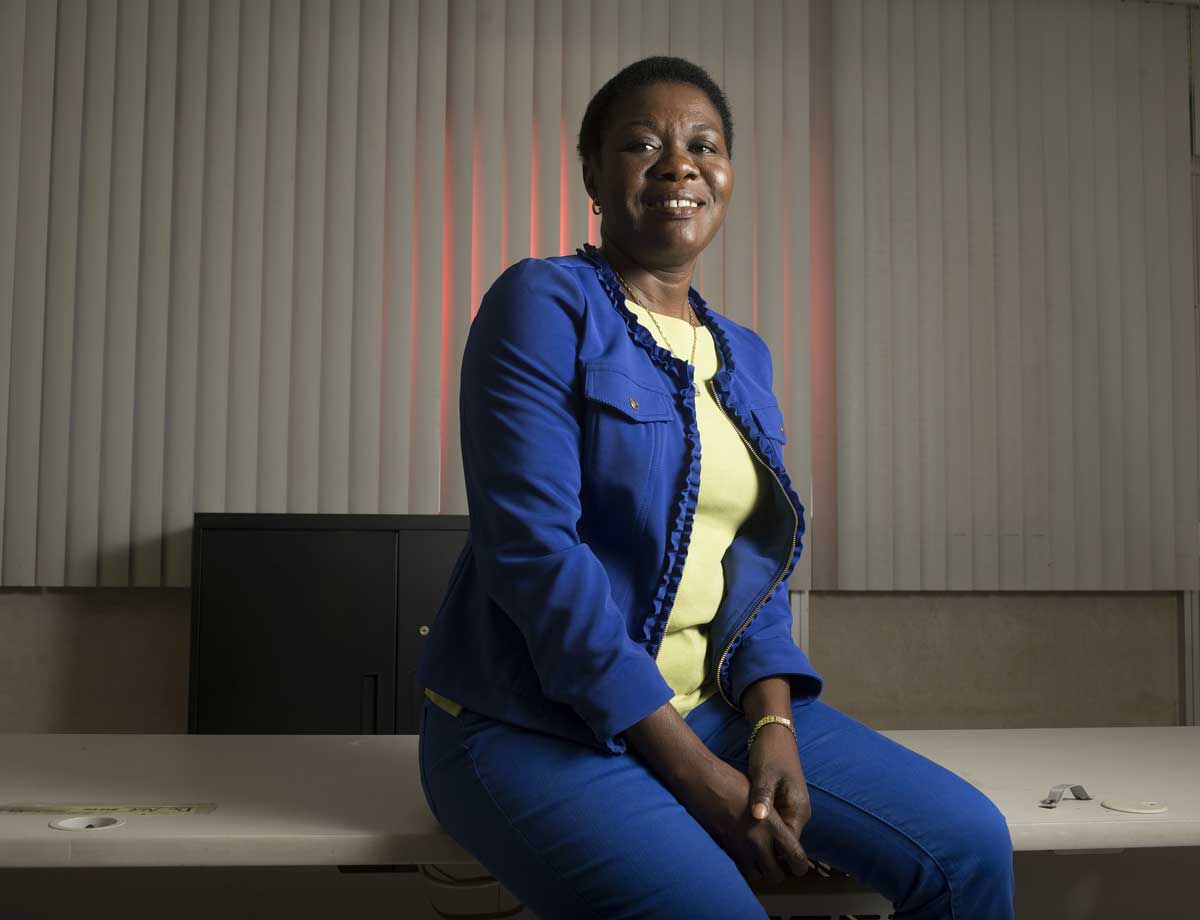Olukemi “Kemi” Sawyerr Story

Students Manage Their Own Startup Company
A chance conversation between Associate Professor Olukemi “Kemi” Sawyerr of the College of Business Administration and Associate Professor Winny Dong of the College of Engineering has created one of the most collaborative projects on campus. Poly Presents is both a class and a company that enables students to introduce a new product into the marketplace. The class has successfully sold viscoplastic fluid snow globes and antibacterial paint by relying on Cal Poly Pomona’s greatest strengths: innovative technology and talented students.
Professor Sawyerr spoke with CBA’s Public Affairs Officer Marisa Demers to talk about Poly Presents.
What is Poly Presents?
Sawyerr: Poly Presents is a startup company run by Cal Poly Pomona business and engineering majors. The students take a new technology through product development and full commercialization. It’s unique in that most engineering entrepreneurship programs across the nation typically only go as far as the planning stage. Students do not get the opportunity to implement their plan. In Poly Presents, the students have to execute the plan they have developed.
What was the impetus for Poly Presents?
Sawyerr: I was sitting in a committee with Professor Winny Dong of the Chemical and Materials Engineering Department and she told me that they have all these technologies that they come up with in their labs and they don’t do anything with them. They just shelve them. She asked, “Can you help us?” So, together we developed a solution – a learn-by-doing experience that is a collaboration between business and engineering students.
How does it work?
Sawyerr: The fall quarter begins with a number of inventors pitching ideas to the students. The students and the faculty sign non-disclosure agreements with each inventor. The students form groups around specific innovative technologies and spend fall quarter turning them into working prototypes. In addition, they develop business plans for their new products. At the end of fall quarter they vote on one product to pursue.
Winter quarter is devoted to product testing, research and development and a full-fledged business plan. They also receive “training” in accounting, marketing and business planning as well as production planning and engineering through guest lecturers. This is to ensure that both business and engineering students are equipped with the knowledge and skills they need to run successfully run their business.
Spring quarter is devoted to the manufacturing and sale of the product.
What was the Poly Presents product for the 2010-11 school year?
Sawyerr: The product was called Bronco Time, in line with the two previous products – Bronco Globe and Bronco Paint. Bronco Time does not have traditional clock hands. Instead, it tells time by moving two neodymium magnets across the face of the clock. On the base of the clock is a ferrofluid tube with a magnet wand attachment that demonstrates the magnetic properties of the ferrofluid. What is innovative about the product is the use of neodymium magnets to tell time instead of traditional clock hands.
How is this class a learn-by-doing experience?
Sawyerr: I can’t imagine anything more learn by doing. From the time the students walk into the classroom they are expected to apply what they have learned in their various disciplines to the project. For instance, our two accounting students in the class are co-CFOs. They have been managing all the books, they have created an accounting control system and they have prepared the budgets and all the financial statements. Professor Dong and I serve as facilitators and consultants, but the students run the class. They start and run a new technology venture during the course of the academic year. This is the ultimate in learn-by-doing!
How else do students benefit from this class?
Sawyerr: It’s a class where you learn about yourself, you learn a lot about people and you learn a lot about running a business. This is not the type of course where you just wait for the professor to tell you what to do. Students have to take initiative, be self-starters. They blossom in this class. They discover how truly talented they are. Students do not get that experience anywhere else.
The experiences they write about in their reflection papers are those they wouldn’t get if they didn’t take this course. They produce meticulous plans and when it is time to implement the plan they face many challenges. They have to to come up with solutions off the fly. They learn how to work with people who are not like them. Engineering and business people don’t think alike. They’re very different because of their training. They learn to work together to successfully run their company.
What are your long term plans for Poly Presents?
Sawyerr: I wish that every CBA student had this opportunity. My traditional classes are so structured that students never get to demonstrate their unique talents. In this class, because they are truly in charge of running the firm from new product development to production and marketing, the students demonstrate how truly talented they are. I think they even surprise themselves! They definitely surprise me. After having taught this course for three years, I am truly convinced that Cal Poly Pomona students are jewels. So, first I’ll like to see us scale up this course so more students and faculty members have the opportunity to gain such an experience. In order to accomplish the above, we need the funding to scale up the course. The course is designed to be self-supporting. The money that each cohort makes is reinvested back into the course. The initial seed money of $2,000 provided by the College of Engineering was turned into $2,200 by the first cohort, a 10% return on investment. So, the second cohort started with $200 in additional funding than the first cohort had. This third cohort stated with $2,500 due to the 13.6% ROI achieved by the second cohort.
We are actively looking for funding. The lack of funding limits the students as to which technology they can pursue for development. . Given additional funding, they can do bigger and better things. If they had say $10,000, they could pursue more complex technology for development. So, second I’ll like to see us get a sponsor that would fund the course at more significant levels that what we currently have to work with.
2011-04-29
